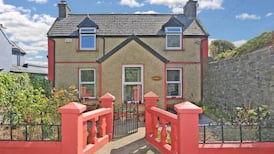“The reservation of a rose and a grain of wheat by the year” was the rent agreed for Dripsey Castle in 1600, although the new purchasers of Dripsey Castle estate will have to pay a little more than that.
But look at what they will get: a creeper-clad Georgian mansion set on an embankment above the Dripsey river, reached by an avenue cut through ancient and well-maintained woodland, backed by 110 acres of tillage and pasture with a cobbled coachyard and a range of slated sandstone buildings, all set deep into an authentic pastoral landscape.
Privacy with access is often a big selling point for country properties and this one emphatically has both, close to two villages as well as to the main road eastwards to Cork and westwards to Killarney. The castle itself is a five-storey tower house built five centuries ago and leased from branch to branch of the MacCarthy lords of Muskerry.
0 of 6
Known also as Carrignamuck, its first proprietor was Cormac Laidir MacCarthy, clan-leader and founder of nearby Blarney Castle, Castlemore and Kilcrea. Cormac met his end here at his Dripsey fortress, murdered by his brother and nephews in 1494.
Picturesque scene
Now the castle stands as an outpost to the house built in 1740 by the Colthursts, also of Blarney. While the castle makes a picturesque scene across the dammed river, the house is invisible, its seven-bay façade looking over lawned slopes bordered by rhodendrons, azaleas and shrubberies slanting into the protective woodlands .
It is character as much as architecture which gives this house its intrinsic charm. Its shallow perron ends at the square-headed door but nonchalantly leaves a limestone footprint immediately inside the hall. All the best features of modest Georgian architecture are evident in the main rooms where the high ceilings are garlanded with delicate stucco. There are impressive and deeply-recessed fireplaces with high baskets, full-length shutters on all the windows and the nine bedrooms – the main first-floor ones large and light-filled – are reached from a mahogany staircase.
The wide landing is lit by a tall Venetian window and at the moment is giving house-room to a professional-sized billiard table. While this main house has not been lived in for some years it remains fresh to the eye, warm, dry and suggestive of comfortable adaptation.There is, for example, an estate room with a window giving on to the coachyard which could be used as a morning room, study or office.
Refurbishment project
Although the kitchen area is empty, its large well-lit space is complete with its winter hedge and flitch or drying hooks on the ceiling.
Selling agent Joe McCarthy of Irish and European (with Ganly Walters) says the house is a project for refurbishment. There is an attractive three-bedroomed wing immediately alongside, adapted from the former ballroom and instantly habitable with three reception rooms, three bedrooms, a bathroom and a large modern kitchen. This also has its own garden dividing it from the coachyard.
This historic property is of great importance in the life of the neighbourhood and of Ireland. In 1903 the Colthursts were followed by the O’Shaughnessy family led by innovator and entrepreneur Andrew O’Shaughnessy, TD, founder of Dripsey Woollen Mills (and father of 13 children with five of his six daughters becoming nuns).
The dammed river was used to power the mill turbines and to provide electricity for the house. This is still possible even though the mill closed after the collapse of the textile industry in the 1970s. But the O’Shaughnessys continued at Dripsey Castle until a short time ago.
Their successors will find a mansion with a castle and a two-bedroomed gate-lodge, and above all a location of incomparable rural tranquility.
























